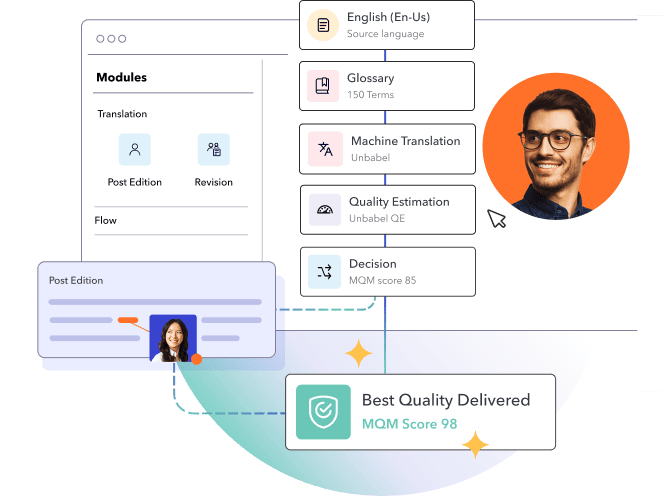
Translation Giant TransPerfect Acquires Unbabel's AI Technology to Build Integrated Language Platform
The Language Consolidation: How TransPerfect's Unbabel Acquisition Signals the End of Translation's Wild West
NEW YORK — TransPerfect, the world's largest provider of language and AI solutions for global business, announced Thursday its acquisition of Unbabel, a Portuguese artificial intelligence company that has emerged as a market leader in translation technology. The deal, with undisclosed financial terms, brings together two companies whose combined capabilities could reshape how enterprises approach multilingual communication.

Founded in Lisbon in 2013, Unbabel graduated from Y Combinator, the prestigious startup accelerator that has produced companies including Airbnb, Coinbase, and Stripe. The company built its reputation on TowerLLM, the first large language model specifically designed for translation, and COMET, which has become the industry's benchmark system for evaluating machine translation quality.
"Unbabel is a pioneer in developing AI models for use in translation," said Phil Shawe, TransPerfect's President and Co-CEO. "We see combining tech stacks as a major win for our shared clients—and we will continue to drive efficiencies through innovation."
The acquisition integrates Unbabel's specialized translation technologies into TransPerfect's GlobalLink platform, creating what may be the first comprehensive language AI ecosystem combining model development, quality measurement, and enterprise distribution. Vasco Pedro, Unbabel's Co-Founder and CEO, will remain with the company to oversee the integration process.
This consolidation arrives at a pivotal moment for the language services industry, where artificial intelligence is simultaneously automating routine translation work while creating new demands for specialized, high-quality multilingual communication. The merger represents a strategic shift from competing primarily on cost and efficiency toward competing on measurable technological capabilities.
When David Builds Goliath's Arsenal
Unbabel's crown jewel, TowerLLM, represents a paradigmatic shift in translation technology. Unlike general-purpose language models that treat translation as an afterthought, TowerLLM was purpose-built for multilingual communication, trained on years of proprietary linguistic data that outperforms industry giants including GPT-4o, Google Translate, and DeepL across multiple domains.
The technical superiority stems from fundamental architectural differences. While mainstream models prioritize broad conversational ability, TowerLLM's design philosophy centers on linguistic precision and cultural nuance—attributes that matter when miscommunication can cost multinational corporations millions in regulatory compliance or brand reputation.
Conceptual chart comparing TowerLLM's translation quality scores against competitors like GPT-4o and Google Translate across domains such as legal, medical, and marketing.
| Domain | TowerLLM COMET Score | GPT-4o COMET Score | Google Translate COMET Score |
|---|---|---|---|
| Legal | Significantly Outperforms Competitors | High | Competitive |
| Medical | Significantly Outperforms Competitors | High | Competitive |
| Marketing | High | High | Standard |
Equally significant is Unbabel's COMET system, which has become the industry's de facto standard for evaluating machine translation quality. Owning both the translation engine and the measurement methodology creates what market analysts describe as a "quality-as-a-service" paradigm—the first time an enterprise can purchase translation outcomes with measurable, contractual quality guarantees.
The Vertical Integration Revolution
The strategic brilliance lies in TransPerfect's existing GlobalLink technology portfolio, which already manages multilingual content workflows for Fortune 500 companies worldwide. By integrating TowerLLM and COMET into this established infrastructure, TransPerfect transforms from a service provider competing on efficiency to a technology platform selling measurable outcomes.
Vertical integration is a business strategy where a company acquires another business operating at a different level of the same industry's supply chain. This strategy allows a company to control more of its production process to increase efficiency and reduce costs, though it also carries risks like high capital investment and reduced flexibility.
Industry observers note this mirrors successful consolidation patterns in adjacent sectors. The playbook resembles how Salesforce absorbed marketing automation tools or how Amazon integrated logistics capabilities—building comprehensive platforms that become increasingly difficult for competitors to replicate or clients to abandon.
"The competitive moat here isn't just technological," explains a senior analyst at a prominent technology investment firm who requested anonymity. "It's operational integration at enterprise scale. Once quality measurement becomes embedded in procurement workflows, switching costs become prohibitive."
Market Tremors Across Silicon Valley and Beyond
This acquisition arrives amid broader industry upheaval. The language services market, valued at $71.7 billion with projected growth to $75.7 billion, faces simultaneous disruption from artificial intelligence automation and consolidation pressure from cost-conscious enterprise buyers.
Projected growth of the global language services market from 2024 to 2028.
| Year | Projected Market Value (USD Billions) |
|---|---|
| 2024 | 71.53 - 75.5 |
| 2025 | 76.24 |
| 2028 | 81.79 - 95.3 |
Recent months have witnessed parallel moves across the sector. RWS consolidated machine translation capabilities through SDL and Iconic acquisitions, relaunching the Language Weaver brand. Lionbridge absorbed Gengo to control crowdsourced translation data. Sorenson Communications acquired OmniBridge and Hand Talk for AI-driven sign language interpretation.
The pattern suggests an industry in fundamental transition—moving from labor-intensive services toward technology-enabled platforms where data, algorithms, and distribution channels determine competitive advantage.
Investment Calculus in an AI-First World
For institutional investors monitoring this space, the TransPerfect-Unbabel combination presents a compelling case study in vertical integration strategy. The acquisition creates multiple revenue expansion opportunities: API licensing for TowerLLM, COMET evaluation services for third parties, and premium quality-guaranteed translation tiers for enterprise clients.
Market analysts suggest this model could command significantly higher margins than traditional per-word translation pricing. Quality-anchored service level agreements allow outcome-based pricing that scales with client value rather than content volume.
The broader investment thesis centers on data network effects. TransPerfect's existing enterprise relationships generate continuous streams of post-edited translations—precisely the high-quality bilingual data required to maintain TowerLLM's competitive edge. This creates a virtuous cycle where better data produces superior models, attracting more clients, generating more data.
However, risks remain substantial. Foundation model developers at OpenAI, Google, and Anthropic continue rapidly improving general-purpose translation capabilities. If large language models achieve parity with specialized systems, TransPerfect's technological advantage could erode quickly.
Regulatory Crosscurrents and Labor Implications
The acquisition occurs against complex regulatory backdrop, particularly in Europe where AI governance frameworks increasingly scrutinize automated decision-making systems. COMET's role as industry evaluation standard could attract regulatory attention if quality measurements influence contractual obligations or compliance determinations.
Labor dynamics present additional complexity. Translation professionals, already pressured by automation, may view this consolidation as accelerating displacement. However, industry data suggests AI augmentation rather than replacement, with human expertise remaining essential for cultural context, regulatory compliance, and quality assurance.
The integration of speech and media capabilities represents the next battleground. AI dubbing and real-time interpretation technologies show rapid advancement, but regulatory frameworks around voice rights, consent, and cultural sensitivity remain underdeveloped.
Strategic Imperatives for Competitors
TransPerfect's move forces immediate strategic responses across the competitive landscape. RWS, Lionbridge, and other major providers must now decide whether to develop comparable technological capabilities internally, acquire remaining specialized AI companies, or accept positioning as services-only organizations.
Venture capital activity likely accelerates around complementary technologies: evaluation tooling beyond COMET, domain-specific translation models for regulated industries, and speech/media localization platforms. The window for standalone translation AI companies may be closing rapidly as platform integration becomes table stakes.
Developer-focused platforms like Crowdin, Lokalise, and Transifex become attractive acquisition targets, offering direct access to software development workflows where translation automation delivers immediate productivity gains.
The Measurement Revolution
Perhaps most significantly, this acquisition establishes quality measurement as a competitive differentiator rather than operational afterthought. For decades, translation buyers relied primarily on vendor reputation and sample reviews. COMET's integration into TransPerfect's workflow enables objective, quantifiable quality scoring at enterprise scale.
A conceptual chart showing the shift in translation procurement from subjective factors (reputation) to objective, data-driven quality metrics (COMET scores).
| Evaluation Factor | Subjective Approach (Traditional) | Objective Approach (Data-Driven) |
|---|---|---|
| Primary Quality Metric | Holistic scoring by human evaluators based on subjective judgment of accuracy and fluency. | Automated metrics like BLEU score and AI-driven COMET (Crosslingual Optimized Metric for Evaluation of Translation) scores that predict human judgments. |
| Vendor Selection | Based on reputation, references, and manual review of sample work. | Data-driven vendor management, analyzing supplier performance data, and leveraging technology for vetting. |
| Technology Reliance | Reliance on human translators and reviewers with minimal technological integration. | Heavy reliance on Translation Management Systems (TMS), AI, machine translation, and automated quality checks. |
| Focus of Evaluation | General sense of quality, readability, and cultural appropriateness. | N-gram precision, semantic similarity, post-editing effort, and correlation with human judgments. |
This transparency could reshape procurement processes across global organizations. Chief procurement officers gain tools to compare translation suppliers using standardized metrics rather than subjective evaluations. The implications extend to regulatory compliance, where measurable translation quality becomes essential for industries like pharmaceuticals and financial services.
Early indicators suggest enterprise appetite for quality-guaranteed translation services, particularly in regulated sectors where translation errors carry legal and financial consequences. This premium positioning allows pricing strategies disconnected from traditional per-word commoditization.
Future Trajectories in a Consolidating Industry
The TransPerfect-Unbabel combination represents an inflection point toward platform-based competition in language services. Success will depend on execution of technical integration, preservation of Unbabel's research culture, and effective monetization of quality measurement capabilities.
Market dynamics suggest further consolidation as remaining independent providers lack resources to compete against integrated platforms. The industry's future structure likely resembles other technology-enabled services sectors: a small number of comprehensive platforms serving enterprise clients, with specialized providers capturing niche markets or specific geographic regions.
The potential future market structure of the language services industry, dominated by a few large platforms with the remainder comprising niche players.
| Market Segment | Description | Key Players / Composition |
|---|---|---|
| Super Agencies | A small number of large, full-service Language Service Providers (LSPs) with revenues exceeding USD 200 million, holding a significant portion of the market share. | TransPerfect, LanguageLine Solutions, RWS Holdings |
| Leaders & Challengers | LSPs with revenues ranging from approximately USD 8 million to USD 200 million, competing for market share below the top tier. | This segment includes several hundred companies globally that are significant in size but do not have the market dominance of the Super Agencies. |
| Niche & Boutique Players | The vast majority of the market, consisting of thousands of smaller, often specialized, LSPs with revenues typically below USD 8 million. | This fragmented segment accounts for a very large portion of the total number of companies in the industry and represents a substantial part of the overall market. |
For global enterprises managing multilingual operations, this consolidation offers both opportunities and risks. Integrated platforms promise simplified vendor management and quality assurance, but market concentration could limit competitive pressure on pricing and innovation.
The ultimate measure of this acquisition's success will be whether TransPerfect can transform language services from a necessary cost center into a strategic capability that enables global business expansion. In an increasingly connected world where communication barriers directly impact economic opportunity, that transformation may prove more valuable than any individual technology or market position.

Investment advisory: Past performance does not guarantee future results. Readers should consult qualified financial advisors before making investment decisions. Market conditions and regulatory environments may significantly impact outcomes described in this analysis.